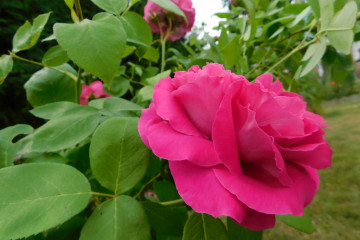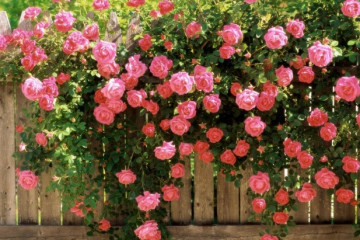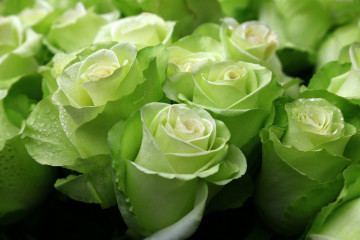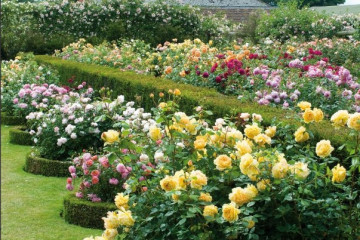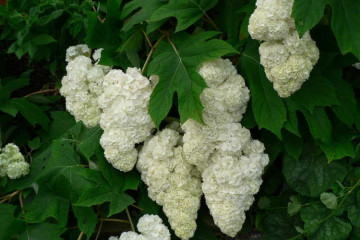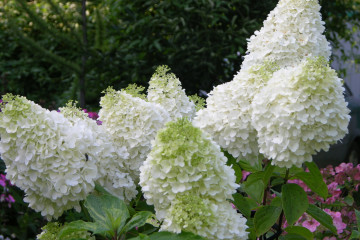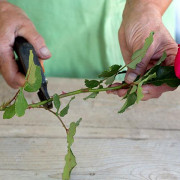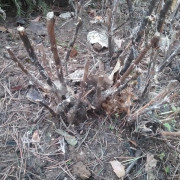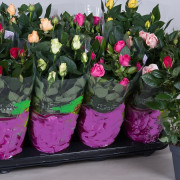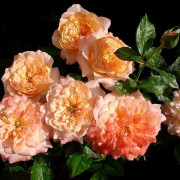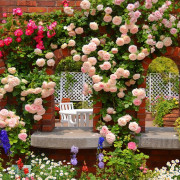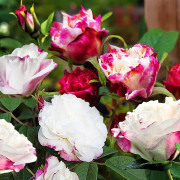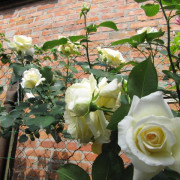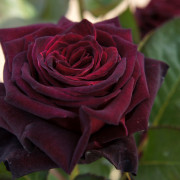What roses are the most unpretentious and winter-hardy
Content:
Rosaries require a lot of work, protection from frost and pests, but breeders have developed special frost-resistant varieties to make it easier for gardeners to take care of them. They bloom continuously until autumn frosts, do not require shelter, and are not afraid of diseases. Before breaking down a flower bed, you should familiarize yourself in advance with which roses are the most unpretentious and winter-hardy, and evaluate their quality characteristics.
How to choose roses for central Russia
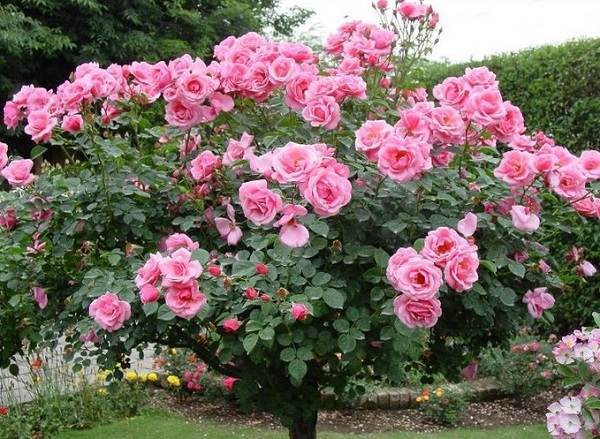
Breeders are breeding more and more perfect varieties of roses with exceptional properties
The central part of Russia is known for its harsh climate, in which winters are cold, the weather is windy, snowy, with a sharp temperature drop. When choosing the most unpretentious bush roses, the gardener should buy planting material in special stores or nurseries, where their cleanliness is ensured.
What to look for when buying a seedling:
- There should be no signs of decay, dry areas, damage on the roots and stems. The rhizome of a quality bush is powerful, branched. Unhealthy specimens will not tolerate severe frosts and snowless winters.
- The health of the seedlings will be confirmed by loose, without musty odor, insects and traces of mold on the root system.
- Frost-resistant roses are grafted onto a winter-hardy type of wild rose. Therefore, you should check with the seller which parent plant the seedling had.
An important criterion is the neat appearance of the shrub. Florists want the rose bush to always be in order, it does not have dead wood, rotting buds that need to be cut off with pruning shears.
Self-cleaning rose varieties such as Hommage a Barbara, Kronborg, Heidi Klum Rose, Santana, Giardina, Ascot, Lady of Shalott, Winchester Cathedral, Dieter Muller are more often chosen for themselves. In the catalogs, these roses appear under the name Rigo-Rosen (cold-resistant varieties).
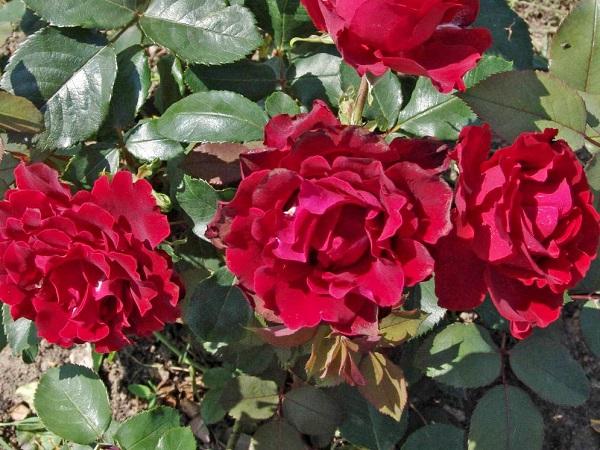
Hommage a barbara
How to choose roses for growing in Siberia and the Urals
The harsh climate of these regions dictates its own rules for choosing ornamental plants. Winters are long here, spring is late, warm days are rare. Seedlings should be bought already adapted to such weather conditions. Unpretentious varieties of perennial roses for these regions are:
- Residence;
- Stadt rum;
- Eskimo;
- Larissa;
- Fairy;
- Sunny fairy tale;
- Jazz.
For the northwestern regions, it is better to choose ground cover creeping varieties of species:
- patios - undersized, ridged, landscape;
- floribunda - landscape, flower beds with abundant flowering;
- Canadian - Aisha, Queen of the North, Casanova, Abusta.
The latter group is the most preferable, since the climate in Canada is the same as in the north of Russia. Roses grafted to mother plants grown in Siberia or the Urals tolerate severe frosts well.
Types of winter-hardy roses
Breeders distinguish 3 groups of roses that do not require shelter for the winter:
- Absolutely winter hardy varieties. Roses can withstand frost in an upright position, do not require special care and protection. Shrubs grow up to 2 m in height and 1.5 in width, always bloom profusely and smell strong. Branches crawl along the ground, so it is better to plant them near the fence. The best climbing roses for central Russia are Rambling Rector, Super Excelsa, Snow Goose, Super Dorothy.
- Medium-hardy varieties. Winter is tolerated without shelter if the climate is relatively mild and there is a lot of snow in winter. The stems of roses are bent to the ground so that they are better covered with snow. In very harsh winters, the bushes can freeze slightly. The best persistent roses from the floribunda group are Luminion, Evelyn Fison, Arthur Bell, Deja Vu, Jack Frost, Sunsprite (Freesia).
- Relatively winter-hardy varieties. In regions with a mild climate, roses hibernate without shelter. For cultivation in northern latitudes, the species requires an air-dry shelter or sprinkling with earth. Some parts of the shrub can freeze slightly, but in the spring the sick branches recover quickly. The most winter-hardy roses of Canadian selection are Wasagaming, Charles Austin, Morden Centennial.
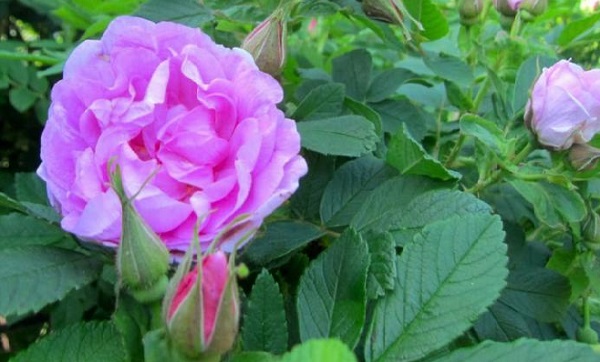
Wasagaming
The best types of roses for giving
The most suitable crops for summer cottages and backyards are listed below.
Stamp roses
Such varieties are considered a real decoration of rose gardens. Rose bushes look like a small tree - from 60 to 180 cm tall. The trunk is a rosehip shoot on which a hybrid is grafted. You can immediately make a stock of several varieties of different colors - it all depends on the idea, what kind of composition you want to get in the end. For grafting, you need to choose varieties that are suitable in height:
- spray roses or curbs - height 60–90 cm;
- floribunda and flower beds - 90–120 cm;
- ground cover or climbing - up to 180 cm;
- tea-hybrid - bush height up to 140 cm.
Curly or climbing roses
The branches of the bush can reach a length of 5 m. In landscape design, they are allowed to weave arbors, arches, fences. Climbing varieties:
- Rambler. A variety of the old selection. Bushes with thin, soft branches, dense foliage, abundant and long flowering (up to 30 days). Roses grow strongly, require support. Flowers appear only on last year's buds.
- Climbers. Variety with powerful branches, prone to increased shoots, blooms again in one season. Large, up to 16 cm, flowers are formed in the upper and middle parts of the shoots, both last year and young.
- Climings. The result of a mutation of the buds at the gene level, when long branches suddenly grow in ordinary varieties.
Park or English roses
Shrubs with powerful stems, unpretentious, almost do not get sick, tolerate frost well. Lush flowers are used in bouquets for a gift, landscape compositions.
Floribunda
It is a hybrid of tea and polyanthus rose. Low-growing, compact bushes, bloom profusely and for a long time, have inflorescences in the form of panicles. This group of pinks is resistant to disease, temperature extremes. Varieties are used to create continuously flowering flower beds. If you cover the bushes for the winter, they will overwinter at -40 ° C.
Patio
Landscape low-growing shrubs of compact size with a highly branched crown. Patio varieties are bred specifically for landscaping small courtyards, balconies, grow well in flowerpots. The group is resistant to frost, diseases, parasites.
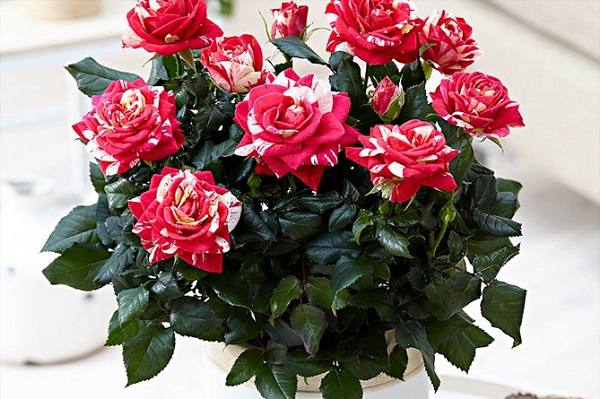
Patio
Groundcover or creeping roses
The shape of the bush is arched, which makes it possible to use roses for landscape design.If you plant varieties with flowers of different colors nearby, you can create the effect of a carpet. This type of rose is prone to increased formation of roots and shoots, which gives plants immunity to diseases.
Shrub varieties of roses or shrubs
All roses can be called shrub roses, but scrub is a “super bush”. They grow 2 or more meters high and have thick, resilient branches. The varieties are frost-resistant, hibernate without shelter, but in the north they require light protection.
Canadian roses
A separate group is frost-resistant roses, which were bred by Canadian scientists.
Charles Austin)
For the Moscow region, this variety is ideal. The bushes grow up to 1.5 m high. The flowers are densely double apricot with a darker core. The shape of the bud is round, in a fully blossoming form it reaches a diameter of 10 cm. The opened petals fade quickly, but this deficiency is compensated by the repeated flowering of the bushes. The variety is resistant to frost (zone 5), diseases, requires periodic pruning.
Morden centennial
The bush grows up to 2 m, throws out pale crimson buds, which, when opened, gradually fade to pink. The first spring flowering is plentiful, autumn flowering is less lush. Fading buds need to be cut: this gives an impetus to the development of new flowers. The variety practically does not get sick, although black spot often appears on the leaves. In severe winters, the bushes freeze slightly, but only at temperatures below 30 ° C.
Wasagaming
An unpretentious rose that absolutely does not need care. The bushes bloom once, throw out large, up to 10 cm in diameter, lilac flowers. The branches are abundantly covered with thorns. Flowering is long, abundant, and when the bush fades, single specimens appear.
Climbing winter-hardy roses
Among the climbing ones, there are also champions in frost resistance.
Super Excelsa
This is an improved version of the winter hardy Excelsa hybrid. The new variety is more resistant to diseases, remontant. On the spreading bushes, dense large clusters of buds are formed, the petals are bright crimson, the middle is white. In the sun, the flowers fade, turn purple with a silvery pink back. The shrub is not a climber, but blooms all summer. The first flowering is very abundant. The variety is planted near low supports. It fits like a stock to create a weeping trunk. The rose is very hardy, but does not suffer in hot climates.
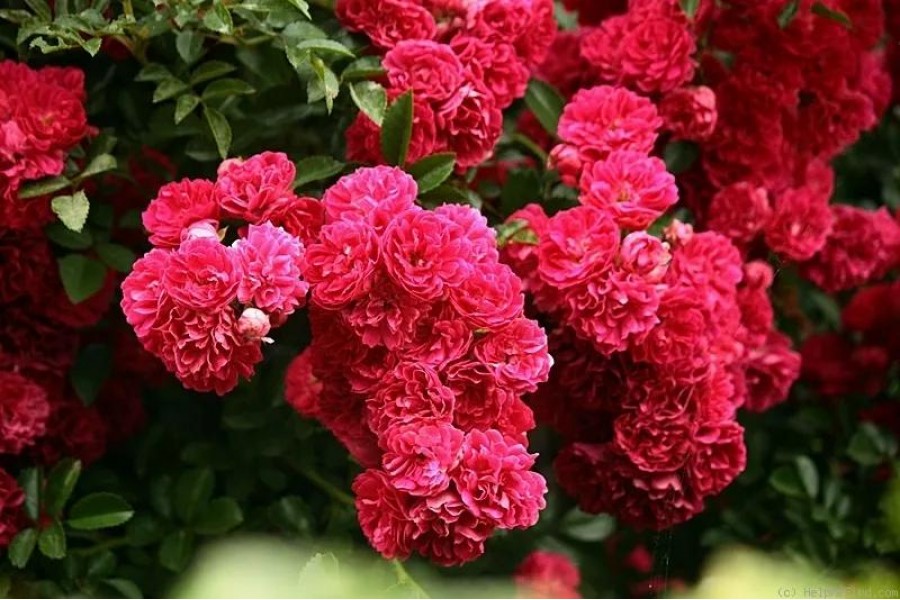
Super Excelsa
Snow goose
This variety is very similar to the Fransine Austin hybrid. Snow Goose bushes bloom with small white roses, collected in large clusters, each of which has up to 20 buds. In appearance, the panicles resemble beautiful dense pompons. Petals of different lengths, like daisies. Variety - remontant rambler, refers more to climbing roses than scrubs. The shrub is resistant to diseases, grows up to 3 m in height, and up to 5 m in southern latitudes.
Rambling Rector
During flowering, the rose bush is covered with voluminous brushes of small white flowers, collected in them by 50 pieces. When fully opened, they become creamy white, with golden stamens visible in the middle. In the sun, the petals fade to white, and the stamens darken. The foliage of the shrub is pale green, the branches are long, spreading, the bush grows up to 5 m tall. The variety tolerates frosts, diseases, easily propagates by cuttings.
Ground cover roses
Among the soil-covering crops, the following hardy crops can be distinguished.
Amber Sun
The bush grows no more than 50 cm in height, spreading in width, covered with flowers all season. The buds are mostly yellow, but their coloration often takes on a coppery hue. They gradually fade and become creamy. The opened flowers are not thick, they have a core with stamens.The buds are collected in bunches of 5–8 pieces, each up to 6 cm in diameter.
Resident
Starting to bloom continuously from July until mid-October, the rose is resistant to variable climatic conditions. It tolerates heat well, does not freeze in winter, does not suffer from diseases. The variety is planted in a damp northern climate. The rose blooms with simple rosehip-like flowers up to 5 cm in diameter, carmine shade with a light core.
Golden Showers
Shade-tolerant rose, intended for cultivation in damp cool climates. A short (30 cm) climber throws out large up to 9 cm pale yellow buds with large wavy petals. Flowering - from early summer to frost.
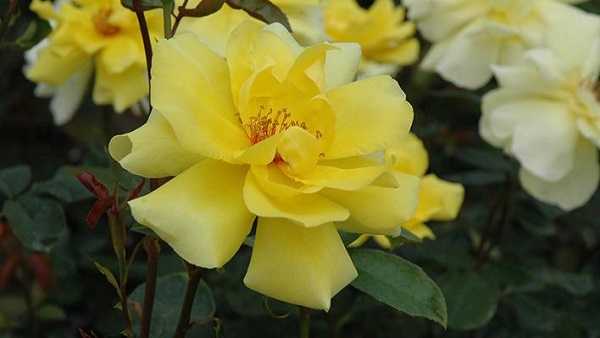
Golden Showers
Floribunda
Of the floribunda, the following crops are most commonly grown.
Arthur Bell
Rose with a fruity aroma is loved by gardeners in England and northern Europe. The shrub begins to bloom early, after the withering of the buds, the second wave of flowering quickly sets in and continues until autumn. Having blossomed, the flowers at first have a bright yellow hue, but then acquire a lemon or cream tone. A bush with tough, thick shoots, abundantly covered with thorns, grows up to 1 meter tall. The variety tolerates frosts, rains well, and is not prone to diseases.
Evelyn Fison
The oldest exhibition rose from the floribunda group. The bushes are small - up to 85 cm tall, compact - they grow in breadth up to 60 cm, the branches are covered with small thorns, the leaves are shiny, dark green. The rose blooms with orange-red full flowers, continuous flowering until frost. The variety belongs to the 6th zone of frost resistance.
Luminion
Another name for the variety is Rosie Mittermeier. The rose blooms with bright red large (up to 8 cm), cupped flowers, collected in panicles of 6-7 pieces. Bushes with a dense crown, erect, grow up to 70 cm. Flowering is moderate, but long.
Shrub roses, or shrubs
The following varieties are distinguished from this group of crops.
Crown Princess Margaret (Crown Princess Margareta)
The bush is 2.5 meters high, with graceful flowing branches. Flowers of a bright apricot shade with a rich fruity scent. The rose blooms profusely from early summer to October. The variety belongs to the most hardy group of tea roses. He is able to survive in a very harsh climate.
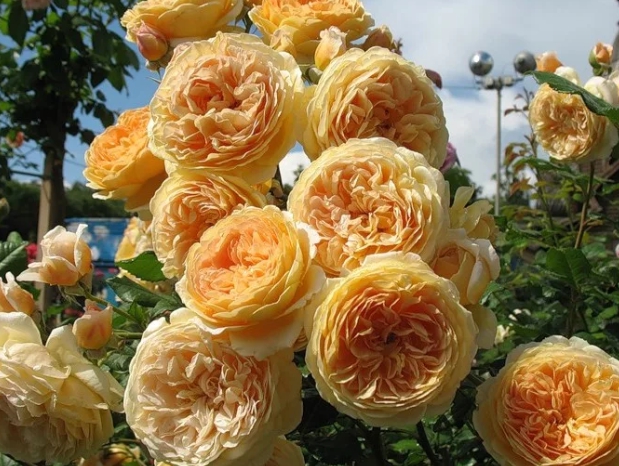
Variety C. P. M.
Snow Ballet
During the flowering period, the scrub is covered with abundant double snow-white flowers, the diameter of which reaches 7 cm. Full buds - up to 25 petals, bloom slowly. The bush exudes a delicate, very weak aroma. The variety is remontant, resistant to diseases, dampness, frost (zone 6).
Toscanini
This is the leader among frost-resistant varieties, it can withstand severe frosts without shelter, subject to strong autumn pruning. In spring, it throws out beautiful red buds, which, when opened, reach 11 cm in diameter. All flowers are the same size. The bushes reach 130 cm in height, have stems of different lengths, so they look slightly sloppy. During the season, the rose blooms twice.
As you can see, there are incredibly many hardy species and varieties of roses, so it is impossible to answer the question - which roses are the best. It all depends on the taste. Thanks to this variety, you can admire their lush and bright flowering on your site for most of the year.
